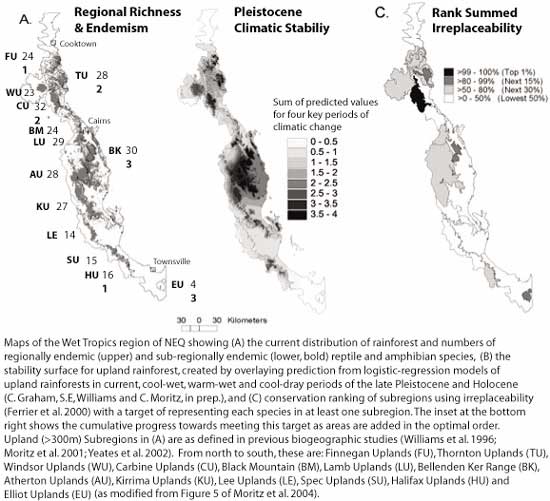 |
Macroecology
of the Australian Wet Tropics
To develop an integrated theory on the determinants of Australian Wet Tropics
(AWT) vertebrate assemblage structure, we plan to examine
patterns of diversity over a range of spatial scales and to
include perspectives from traditional ecology and the related
fields of evolutionary biology, population genetics, phylogeography,
landscape ecology and biogeography. Over the past decade,
there has been renewed interest in how historical biogeographic
and evolutionary processes, together with local ecological
interactions, affect the richness and structure of species
assemblages (Ricklefs & Schluter 1993; Brown & Lomolino
1998; Hubbell 2001; Jansson & Dynesius 2002; Chase 2003;
Ricklefs 2003). In general, the more specialized, lower vagility
and smaller-area-requiring species are expected to be the
most prone to isolation during periods of habitat contraction.
In turn, the richness and composition of a local species assemblage
should be influenced by the dynamics of local extinction,
speciation and colonization from adjacent areas (MacArthur
& Wilson 1967, Rosenzweig 1995, Hubbell 2001).

Most analyses of diversity in this system have been at a
subregional scale and focused on the upland (>300m) areas
(FU to EU, Fig, 2) across which the endemic species are concentrated.
The richness and structure of rainforest vertebrate assemblages
vary among subregions, with the richness of all groups being
influenced positively by area and negatively by geographic
shape (convolution) of rainforest (Williams & Pearson
1997; Williams 1997), and there is significantly nested species
distributions between putative refugia and expansion areas
(Williams and Pearson 1997; Williams and Hero 2001). Further
analysis, using spatial predictions of upland forest types
under various paleoclimates, showed that patterns of subregional
richness and turnover were better explained by including the
“stability surface”, i.e. areas inferred to be
continuously suitable for upland rainforests (Graham, Williams
& Moritz, in prep.; Table 1). Overall, these statistical
analyses of vertebrate species diversity suggest a strong
influence of history, particularly for the more dispersal
limited amphibian and reptile species, with rainforest contraction
at the LGM causing local extinctions, some of which were recovered
by recolonisation from adjacent refugia during the cool-wet
phase of the early Holocene (Williams and Pearson 1997; Schneider
and Williams, in press; Graham, Williams & Moritz, in
prep.). In conjunction with data on the current distribution
and abundance of species across habitats and climatic zones,
we propose to use a novel molecular approach - multi-locus
nuclear estimates of historical demography from co-distributed
species that vary in both vagility and degree of climatic/habitat
specialisation, to test two key hypotheses; That species which
are the most restricted to specific habitats and which have
the narrowest current climatic range have been the most sensitive
to climate-induced habitat contraction; and That the richness
and structure of assemblages at a sub-regional scale should
be determined by responses of individual species to historical
fluctuations in habitat area.
Resolving the history of specific assemblages within and
across subregions where they occur provides a powerful way
of focusing and interpreting research on local-scale interactions.
The AWT meets this challenge by providing a system with the
following attributes; (i) high species richness and endemicity
at a regional scale, (ii) knowledge of key ecological attributes
of species and of spatial patterns of assemblage structure,
(iii) a well characterized history of spatial fluctuations
in habitat distribution, and (iv) estimates of population
responses of species to those changes in habitat distribution.
|
 |
